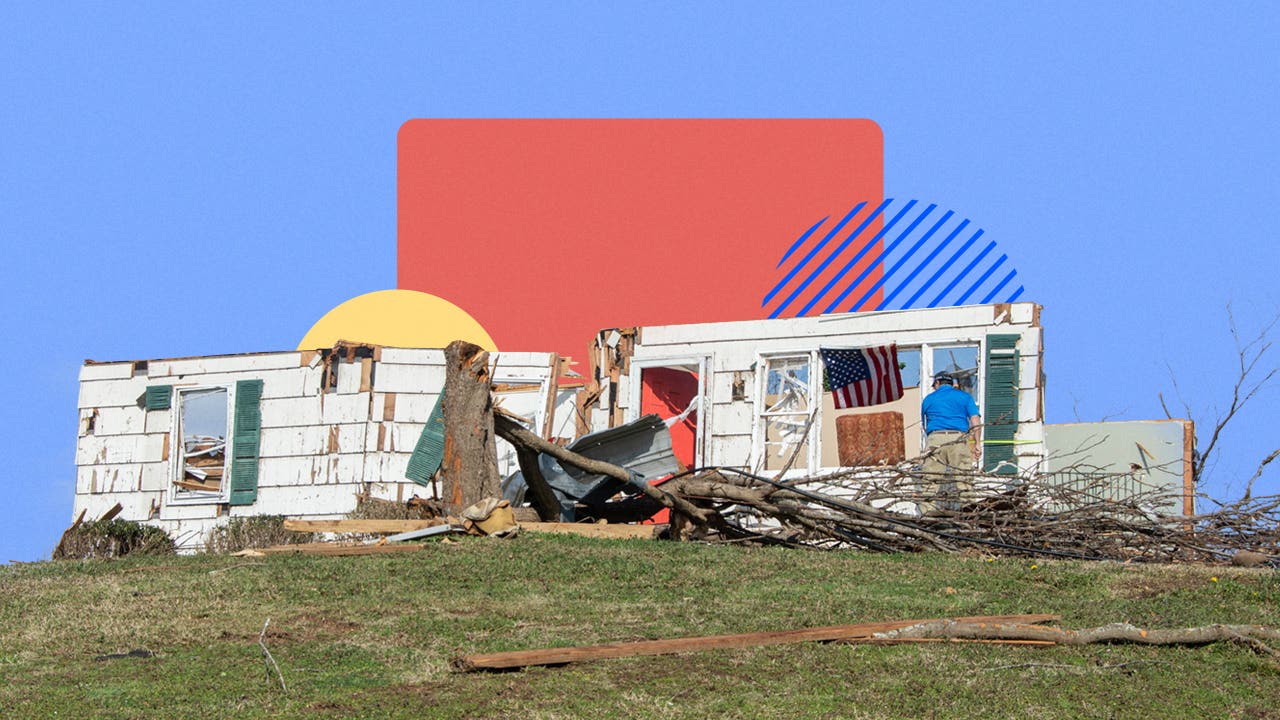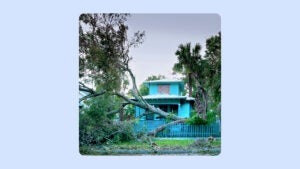Survey: 81% of Americans say higher energy costs or extreme weather have impacted their wallets

Summer 2023 was a season of weather extremes: record-breaking heat across the South, flooding in Vermont and New York and powerful hurricanes on the East Coast. As extreme weather increasingly affects everyday life, it also impacts people’s budgets.
The majority (81 percent) of U.S. adults have incurred costs in the last 10 years due to extreme weather, or paid higher energy bills due to summer 2023’s extreme heat, according to a new Bankrate survey. Specifically, 57 percent of U.S. adults say they have incurred costs due to an extreme weather event over the last 10 years. Over the past brutally hot summer alone, 53 percent say higher than usual electricity bills strained their finances this summer.
Extreme weather events are expected to increase in the coming years, according to the U.S. Environmental Protection Agency (EPA). Accordingly, 57 percent of Americans believe that climate, extreme weather events and the environment will have a negative effect on their finances in the next 10 years.
Unfortunately, extreme weather events are a significant drain on Americans’ finances, and they seem to be getting more common. With only 43 percent of U.S. adults able to pay for a $1,000 emergency expense from their savings, it’s easy to see how unexpected disaster costs can strain budgets and lead to expensive credit card debt and other financial challenges.— Ted Rossman | Bankrate Senior Industry Analyst
Bankrate’s key insights on severe weather’s impact on personal finances
- The majority of Americans have been financially impacted by extreme weather. 57% of U.S. adults say they have incurred costs due to extreme weather events over the past 10 years, such as hurricanes, tornados, wildfires, earthquakes, flooding or heavy snow.
- Higher energy bills are the most common expense from extreme weather. Within the past 10 years, 32% of U.S. adults say they have seen higher energy costs as a result of extreme weather — the most common weather-related cost. 23% of people say they have experienced spoiled food (for example, because of a power outage), 20% say they have had home or property damage expenses and 14% say they have lost income because they were unable to work.
- This summer’s brutal heat may have been havoc on budgets. 53% of U.S. adults say higher than usual electricity bills strained their finances this summer, including 31% whose finances were “somewhat” strained and 23% whose were “significantly” strained. Whether it affected their budget or not, 72% of people experienced higher-than-usual electric bills this past summer.
- The majority of Americans expect costs to continue racking up. 57% of U.S. adults believe climate, extreme weather events and the environment will have a negative effect on their personal finances in the next 10 years, including 33% who expect “somewhat negative” effects and 24% who expect “very negative” effects.
More than 1 in 2 Americans have incurred costs due to extreme weather
More than half (57 percent) of U.S. adults say they have incurred costs due to extreme weather events — such as hurricanes, tornados, wildfires, winter storms and flooding — over the past 10 years. Most commonly, 32 percent of people say they have had higher energy costs, like those seen during this summer’s extraordinary heat wave.
“When we hear of natural disasters, our minds tend to gravitate to catastrophic events such as communities leveled by hurricanes, tornadoes and wildfires,” Bankrate Senior Industry Analyst Ted Rossman says. “And while those events are important and tragic, much smaller-scale events can still have a notable impact. Take this summer’s higher energy bills, for instance. Even a few hundred dollars in extra air conditioning costs can be a big deal amidst the already challenging backdrop of high inflation, high interest rates and record-high credit card balances.”
People also say they incurred costs due to spoiled food (for example, because of a power outage (23 percent), due to home or property damage (20 percent) or because they lost income due to an inability to work (14 percent):
Source: Bankrate survey, August 29-31, 2023
People also say they had extreme weather costs from car damage (13 percent), medical bills (11 percent) and evacuating (7 percent) related to an extreme weather event.
On the other side, 43 percent of people haven’t incurred costs due to extreme weather within the past 10 years.
More people in the South, which is particularly susceptible to heat, hurricanes and flooding, have incurred extreme weather-related costs. Nearly two-thirds (63 percent) of Southerners say they incurred costs in the last decade, compared to 54 percent of Westerners and Midwesterners and 53 percent of Northeasterners.
Nearly 1 in 4 people say higher-than-usual electricity bills ‘significantly’ strained their finances this summer
Nearly three-quarters (72 percent) of Americans say they experienced higher-than-usual electricity bills as they tried to beat the heat this past summer. More than half (53 percent) of people say pricey electric bills strained their finances, including 31 percent who say high electric bills “somewhat” strained their finances and 23 percent who say it “significantly” strained their finances.
In the South, where some locations saw weeks of 100-degree days without break, 77 percent of people noticed higher-than-usual electric bills. That’s compared to 73 percent of Westerners, 70 percent of Northeasterners and 65 percent of Midwesterners.
The majority (59 percent) of Southerners say higher-than-usual electric bills strained their finances, including 28 percent who say it “significantly” strained their finances:
Source: Bankrate survey, August 29-31, 2023
Note: Percentages may not total 100 due to rounding.
In comparison, 55 percent of Westerners, 47 percent of Northeasterners and 46 percent of Midwesterners say high electric bills strained their finances this summer. One in five (20 percent) Westerners, 21 percent of Northeasterners and 18 percent of Midwesterners say it was a “significant” strain.
Among generational lines, middle-aged Americans were the most likely to be financially impacted by the heat. Nearly two-thirds (61 percent) of Gen Xers say higher electric bills from the summer heat strained their finances. Just under one in three (29 percent) Gen Xers say it strained their finances “significantly:”
We asked: Did you experience higher than usual electricity bills this summer, and if so, did they strain your finances?
| Generation | Yes, and they strained my finances significantly |
|---|---|
| Source: Bankrate survey, August 29-31, 2023 | |
| Gen Z (ages 18-26) | 21% |
| Millennials (ages 27-42) | 23% |
| Gen X (ages 43-58) | 29% |
| Baby boomers (ages 59-77) | 18% |
Around half of millennials also say higher-than-usual electricity bills strained their budget (55 percent), followed closely by Gen Zers (51 percent) and baby boomers (49 percent).
As people report higher incomes, they’re less likely to say their finances were strained due to higher-than-usual electricity bills:
- Less than $50,000 a year: 59 percent
- $50,000-$79,999: 57 percent
- $80,000-$99,999: 45 percent
- $100,000 a year or more: 43 percent
Those who make under $50,000 a year were most likely (59 percent) to say higher-than-usual electricity bills strained their budgets, with 30 percent saying it strained their finances “significantly:”
We asked: Did you experience higher than usual electricity bills this summer, and if so, did they strain your finances?
| Yearly household income | Yes, and they strained my finances significantly |
|---|---|
| Source: Bankrate survey, August 29-31, 2023 | |
| Less than $50,000 | 30% |
| $50,000-$79,999 | 24% |
| $80,000-$99,999 | 16% |
| $100,000 or more | 12% |
More than 1 in 2 Americans believe extreme weather will have a negative effect on their personal finances in the next 10 years
More than half (57 percent) of U.S. adults believe that climate, extreme weather events and the environment will have a negative effect on their personal finances in the next 10 years, including 33 percent who believe the effect will be “somewhat” negative and 24 percent who believe it will be “very” negative:
Source: Bankrate survey, August 29-31, 2023
Note: Percentages may not total 100 due to rounding.
Another 34 percent don’t expect much difference either way. Lastly, 9 percent actually expect positive effects. Women are more likely to expect negative effects: 60 percent of women and 53 percent of men expect the climate will have a negative effect on their personal finances.
3 ways for lower-income households to financially prepare for extreme weather
You’re prepared for extreme weather: you’ve built an emergency kit, you know where to evacuate and you know where to turn for aid after a storm. But do you know how you can financially prepare before the extreme weather hits? Extreme weather can have costly consequences, but even if you’re in a lower-income household, there are a few steps you can take to help prepare you for the worst:
1. Build an Emergency Financial First Aid Kit.
The Emergency Financial First Aid Kit (EFFAK), created by Operation Hope, a financial literacy nonprofit, and the Federal Emergency Management Agency (FEMA), breaks down what key documents people should keep together in case of a disaster. The list includes identification documents like driver’s licenses, birth certificates and Social Security cards and has spaces to write down key emergency contact information and medical contacts. Additionally, it provides a list of financial documents to grab, like mortgages, rental agreements, debts, bills, retirement accounts and insurance policies, along with spaces to write those account numbers, due dates, websites and other information. The kit explains what each document is and which documents you may need for disaster recovery.
2. Seek federal assistance for help with high energy bills.
If you’re having difficulty affording your energy bills, you may want to seek assistance from the Low Income Home Energy Assistance Program (LIHEAP). This federal program is used differently in each state, but generally, it helps lower-income families pay their air conditioning or heating bills, provides emergency services in an energy crisis and provides low-cost home improvements, like weatherizing your house, to make it more energy-efficient. The program has some limitations, though. LIHEAP typically can’t pay your entire energy bill year-round and only applies to gas or electric bills used to heat or cool your house, not utilities like water or sewage. You can use the LIHEAP website to find the nearest office in your state.
3. Consider loans to prepare your home for future storm damage.
FEMA and the U.S. Small Business Administration (SBA) partner on some programs to help lower-income households in declared major disaster areas, even if you don’t own a small business. One program offers low-interest disaster loans to homeowners and renters, not only to pay for damage to your home after a disaster, but also to prevent storm damage in the future. These loans can cover losses such as home repair, rental assistance, moving and storage, or even medical care, dental care and funerals if they aren’t covered by FEMA or insurance. Read more at the SBA website or reach out to your local Disaster Recovery Center for more information.
FAQs
-
Hurricane season this year started on June 1, 2023, and will last until November 30, 2023.
-
All U.S. regions have some degree of risk of a natural disaster. Since 1980, Texas, Louisiana and Florida have been the U.S. states with the costliest weather and climate disasters, according to the National Centers for Environmental Information. Each of those states has had at least $300 billion in losses due to droughts, flooding, freeze events, severe storms and other natural disasters.
-
You can prepare for extreme weather by keeping an eye on weather news, signing up for weather warnings from a municipal source near you and creating a plan with your family on how to communicate or possibly evacuate for a weather event. Exact preparations will depend on the type of extreme weather, but in common weather events like a hurricane, you can prepare by making sure you have the proper insurance coverage in advance, having an emergency kit, storing a copy of important documents in a safe place away from your home and securing items around your property.
Methodology
For extreme weather survey data, all figures, unless otherwise stated, are from YouGov Plc. Total sample size was 2,302 US adults. Fieldwork was undertaken between 29th – 31st August 2023. The survey was carried out online. The figures have been weighted and are representative of all US adults (aged 18+). The survey was carried out online and meets rigorous quality standards. It employed a non-probability-based sample using both quotas upfront during collection and then a weighting scheme on the back end designed and proven to provide nationally representative results.
For emergency savings survey data, the study (that was conducted in December 2022) was conducted for Bankrate by SSRS on its Opinion Panel Omnibus platform. The SSRS Opinion Panel Omnibus is a national, twice-per-month, probability-based survey. Interviews were conducted from Dec. 16-19, 2022 among a sample of 1,028 respondents in English (1,003) and Spanish (25). The survey was conducted via web (998) and telephone (30). The margin of error for total respondents is +/-3.5 percentage points at the 95 percent confidence level. All SSRS Omnibus data are weighted to represent the target population.






